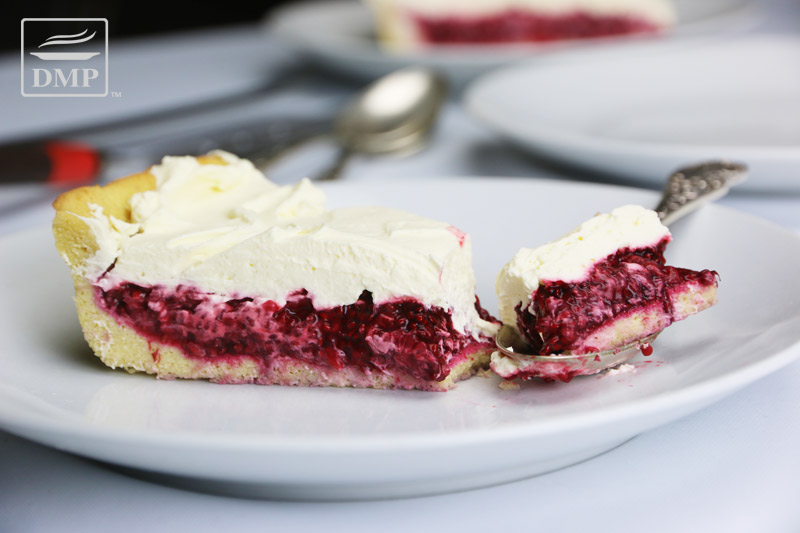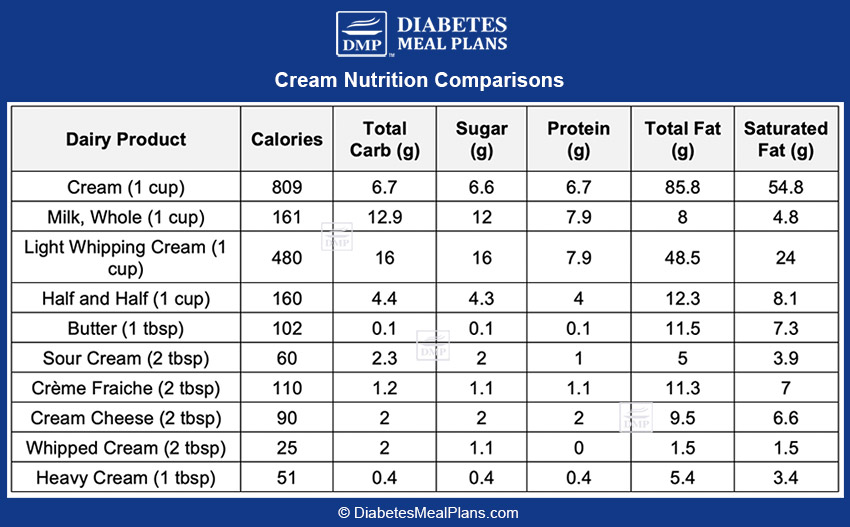What ingredient do a hearty green bean casserole, a rich chocolate cake, and spicy pumpkin latte all have in common?
You may have guessed the answer…it’s cream!
When it comes to adding body and flavor to a variety of different foods, cream really makes the world go round.
However, this high-fat dairy product has been controversial as the “low carb vs low fat” war rages on in the diabetes community, but we’re here to set the record straight and share the most recent research on cream.
Now let’s dig in…

What is Cream?
Cream is a dairy product loved for its richness and…well, its creaminess as the name implies. It is produced by isolating the highest fat containing layer from milk, which gives it a different mouthfeel compared to milk.
Cream is a food familiar to many, often a splash thrown into coffee or the base of a thick, creamy custard dessert. Then of course, you have things such as butter, sour cream and créme fraîche to contend with, which are all made from cream.
If you’ve read our other articles on dairy, you know most dairy is a good choice for someone trying to lower blood sugar and A1c. If you choose correctly, dairy is relatively low in carbs and contains beneficial protein, vitamins, and minerals.
But what about cream? Is higher fat dairy okay to include in a healthy diet?
Being that cream pops up so frequently in many recipes, it seems like an important question to answer.
Cream Nutrition Facts
Because of the way it is made, it’s true that cream contains more fat than regular milk, but interestingly cream contains less sugar (lactose).
The exact amount of fat can vary depending on whether you’re using heavy whipping cream, light whipping cream, or half and half, and interestingly it also depends on what country you’re in.
In general, a half cup of heavy whipping cream contains around 400 calories, 3 grams carbs, 3 gram of protein and 40 grams of fat.
Like other dairy products, cream contains vitamins and minerals such as calcium, phosphorus and vitamin D.
We already mentioned that cream can be used to make things like butter, sour cream, créme fraîche, cream cheese and whipped cream, so let’s explore how all of these items compare in terms of nutrition.

[ssba-buttons]
A Bit About Saturated Fat
The most controversial thing about dairy is the saturated fat content.
Saturated fat has historically been deemed the type of fat that clogs your arteries. Examples of foods that contain saturated fat include red meat, eggs, butter and of course, cream.
For years a low fat diet has been the default treatment for diabetes. This means eliminating things like butter and cream has been commonplace.
However, in recent years more research has come to surface that tells us that eliminating saturated fat is not necessary, and in fact, consuming saturated fat from dairy does not appear to increase your risk of disease, including heart disease.
Interestingly, research suggests heart disease risk increases when you consume a lot of processed foods. Primarily it’s the pro-inflammatory trans fats and other highly processed fats that are responsible for the development of inflammation and cardiovascular diseases. And in terms of cholesterol, eating fat does not necessarily clog arteries – this is a myth. The build up of cholesterol is promoted via inflammation in the vessels.
So.. does that mean cream is okay for someone with diabetes or prediabetes?
Yes. But let’s explore some research to confirm this.

Research on Cream and Diabetes
A 2017 meta-analysis compared diabetes and prediabetes risk with specific subgroups of dairy products. Researchers found that higher high fat dairy intake (cream) was associated with a 63% lower risk of type 2 diabetes, and it was determined neither cheese, cream, or butter were associated with prediabetes.
Ericsson and colleagues found similar results when they studied nearly 27,000 adults and concluded that consuming more high-fat dairy products decreased risk of diabetes, while low-fat dairy showed an increased risk. It was noted that particularly cream, yogurt, and cheese helped decrease risk of diabetes.
Another large analysis reviewed 9 studies concerning another type of full fat dairy: butter. In this review, butter consumption was not associated with an increased risk of cardiovascular disease, stroke or coronary heart disease, and in fact butter intake was associated with a lower risk of developing diabetes.
Other studies have suggested that dairy, including cream, can have a blood sugar-lowering effect when dairy is consumed prior to a meal. It is thought that whey protein may play a role in insulin secretion.
Interestingly, research has also shown that the consumption of high fat dairy, such as butter, whole milk and whipping cream, actually decreases the risk of central obesity. Whereas those who consumed more low fat dairy were found to have increased risk of developing central obesity.
Other studies have found similar results, supporting the conclusion that high fat dairy is not related with obesity risk.
Some may have a hard time understanding how eating fat reduces risk of obesity, but consider this study in which type 2 diabetics were prescribed a low-carbohydrate, high-protein, high-fat diet. Within 14 days of following a low carb, high fat diet participants achieved spontaneous reduction in calorie intake to a level appropriate to their height.
This is because one purpose of fat is to help keep you full (satiated). Including fat in each meal can actually keep you feel more satisfied and cause you to avoid overeating. Awesome news!
Finally, researchers have compared the effect full fat dairy versus low fat dairy had on inflammatory markers in overweight adults.
Studies have found that full fat dairy led to a better metabolic profile whereas the low fat dairy tended to produce higher levels of these inflammatory markers which may in-turn increase the risk of cardiovascular disease.
These researchers noted that the best inflammatory profile was observed after consuming full-fat fermented dairy, which of course would contain beneficial probiotics.
And just as was the case for lowering diabetes risk and obesity risk, full fat dairy has been shown to improve cardiovascular health. Specifically, higher intakes of whole milk, yogurt, and cheese were associated with better cardiovascular function.
Conclusion: Cream for Diabetes: Is it Okay?
The concept of fat clogging our arteries and leading to ill health has been disproven in many scientific studies. Therefore, there is no need to fear cream; whether you enjoy a splash in your coffee in the morning, or enjoy making creamy low carb desserts you can continue to do some with some peace of mind.
Cream is a low carb choice and works great for adding body and a smooth texture to soups, creamy sauces, or rich casseroles. Just remember that cream is higher in calories, and while it’s never necessary to count calories on a low carb diet, we would encourage you to be aware if you are struggling to lose weight.
Also keep in mind that higher fat diets do not pair well with high carb diets. It is normal to increase fat intake when reducing carbs, but to keep both high carbs and higher fat in the diet does not work. For better blood sugar control, choosing healthy natural fats of all kinds is a good choice.

Type 2 Pre Diabetes
Wow, finally some real information with data to back it up! Tired of the usual fearmongering that suggests seed oils such as canola/soybean oil are ‘heart healthy’ when good quality, dairy ideally from grass fed cows is the better option.
I find high fat, medium protein and low carbs works best for me. Agreed that high fat/high carbs is a disaster.
Anna Raddon
Thank you for this excellent, research-based synopsis. Just the information I need to make good choices!
Reuben Mudau
does milk prevent diabetes
Dr Jedha - Nutritionist (PhD)
Hi Reuben, milk on its own won’t prevent diabetes but it is a healthy nutrient dense food source, so as part of an overall healthy diet, dairy products are preventative foods, with research showing they can reduce risk of diabetes.
Kathleen
I have pre diabetes and am wondering if the type 2 diet is the same as press diabetes?
Dr Jedha
Hi Kathleen, yes it is the same and if you follow the right eating plan, most people can get back to normal in around 16 weeks. If you haven’t already, check out our Prediabetes Program here, which can help you achieve normal and makes it all easier!
Linette Lewis
I was recently told I am pre-diabetic. I use a splash or two of heavy whipping cream in my coffee every morning. I’ve been very unsure about my use, so I’ve changed to using it every other day. Thanks for the info.
Emily - Dietitian (MS, RD)
You’re welcome. Stay clear of flavored creamers that contain added sugar but what you’re doing with the heavy whipping cream sounds great!
Rosy Newlun
Thank you, Emily. As an older, retired nurse, recently diagnosed with type 2, even I cannot keep up with all the shouting from different sources claiming which is best foods for us. I would like to know a little more about how low fat can be less beneficial for us rather than reg/higher fat. Many thanks!
Jedha: Nutritionist (MNutr)
We understand it can be conflicting as many people have opinions, and that’s the key: is it an opinion or are the recommendations evidence-based? You also have to assess whether the info being shared is for diabetes prevention or treatment, these are not the same and in many cases people share information aimed at diabetes treatment, when in fact the information comes from studies about diabetes prevention.
Here at DMP, we have been sharing robust evidence since 2015 and our member testimonials are proof that what we share works.
You may find this info and this info useful in answering your question.
M.
Thanks for giving the real low-down on cholesterol etc. Seems that one is still going around, along with the one that all salt is bad. ; ) I can attest to high fat dairy keeping you full longer and no blood sugar reaction ( or at least a slowed one ). But if you’re not used to fats, please take some ox bile or something to help support your gallbladder, at least until you’re used to it! Much more pleasant experience!
Malorie: Dietitian (MS, RD, CLT)
You’re welcome! A little fat goes a long way when it comes to blood sugar balance. Like you said, if you’re not used to a lot of fat you want to introduce it slowly.
Lynn
Amen. Chocolate is OK, but Cream is my go to for desert. Just nice to read this article and reconfirm what I already know. Public Health Specialist with Pre- Diabetes